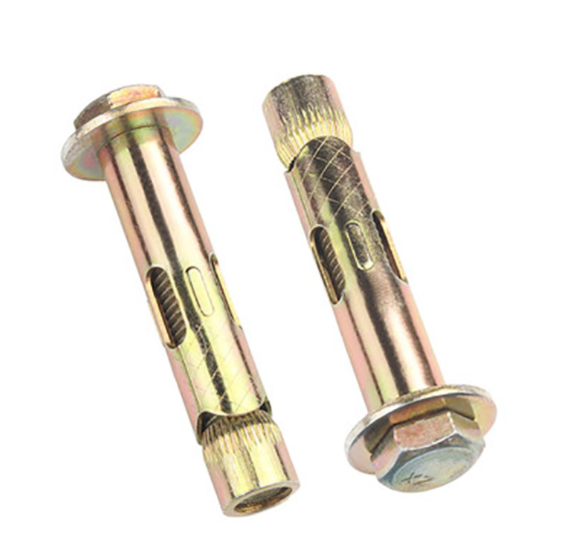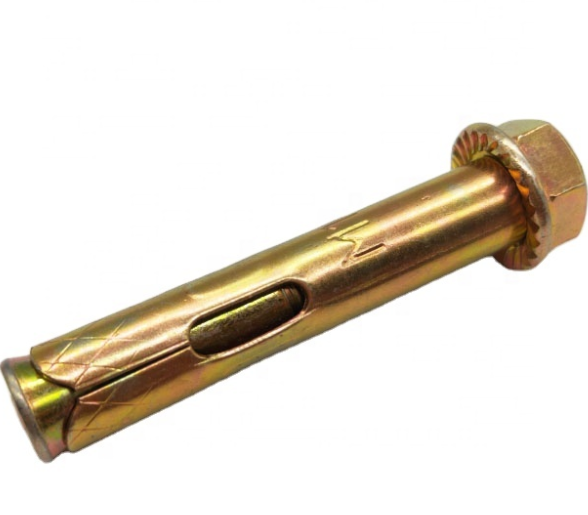Copyright © 2021 Kinfast All rights reserved. 粤ICP备06034726号 Site Map Powered by iwonder.cn
- TEL: +86-755-8347-9123
- E-MAIL: info@kfproduct.com
Sleeve anchors are a quick, simple and adaptable masonry anchoring system. They are designed for application on a range of materials and for applications exposed to seismic loads. When the bolt of the fastener is tightened, it expands against the base material to create a strong connection and is able to distribute load-bearing weight.
Getting the right fixing for your project is crucial to ensuring its effectiveness and long life potential. Sleeve anchors are often permanent fixtures and choosing the right one for the job will increase your project potential.

There are two common types of sleeve anchors. The main determining design features of a sleeve anchor that change its usage are head style, material composition and diameter.
The nut drive is commonly used for extra strength. It is more common than its flat-head alternative and comes in a variety of finishes. Stainless steel fixings such as the A2 S/S sleeve anchor or the Stainless Steel Loose Nut design are corrosion resistant and are most suited for the external fixture.
Bolt head sleeve anchors are suitable for most types of concrete and masonry, capable of securing medium loads with proper application.
Driven Flat Head anchors are typically used when a flush surface is required. This makes the countersunk sleeve anchor option of fixing more suitable for applications where jutting fixtures can cause inconvenience e.g. when opening doors or attachments could be interrupted or cleaner, hidden fixings is a specified factor.
Flathead anchors are fastened into the hole by a suitable screwdriver head (as opposed to the wrench used for nut driven fixings).
All sleeve anchors at Anchor Fixings, from loose nut to CSK head come in a variety of sizes to suit your project.
The importance of cleaning the hole before installing the sleeve anchor cannot be stressed enough. Not only is this step critical for a proper installation, but it is also a guarantee that the anchor will have a maximum holding value. Therefore, do not forget to prepare the insertion spot by removing all potential dust and debris with a wire brush, a vacuum or a compressed air tool.
In case you did not know, the strong bond between the part and the concrete is ensured by friction. The key to making sure you get a solid bond between the material and the sleeve anchors implies drilling a hole of the right diameter and depth. In the event that the hole is too deep or too wide, then there is a fair chance the anchor will come loose in time and that could lead to serious injuries. In addition to planning all the details before actually drilling the hole, you should also consider applying a small amount of epoxy to hold the anchors in place.
While they go by the name of sleeve anchors, keep in mind that there are various categories available, designed for different applications. The cast-in-place bolt is widely used in projects that involve fastening items in concrete due to its special design. Simply put, the head is especially created for a secure and full insertion into concrete, while the thread is left out, making it easier to connect other objects with it.

Even though the sleeve anchors are a great choice for concrete, it is necessary to underline that they are not a universal tool and may not be as efficient when utilized in conjunction with another material. To put it simply, if you decide to use them with a brick and block base for instance, then there is a fair chance they will damage that surface.
Irrespective of the type of project in which you need to use the sleeve anchors, do not forget to read and respect the safety standards, a piece of information you can get from the product description. If you choose to disregard the recommendations on load, spacing or embedment, then keep in mind that it could lead to serious injuries and death because the structure may not be able to withstand a natural disaster or a calamity.
For more information about sleeve anchors, please kindly contact us. As a professional sleeve anchor supplier, we are happy to help you.